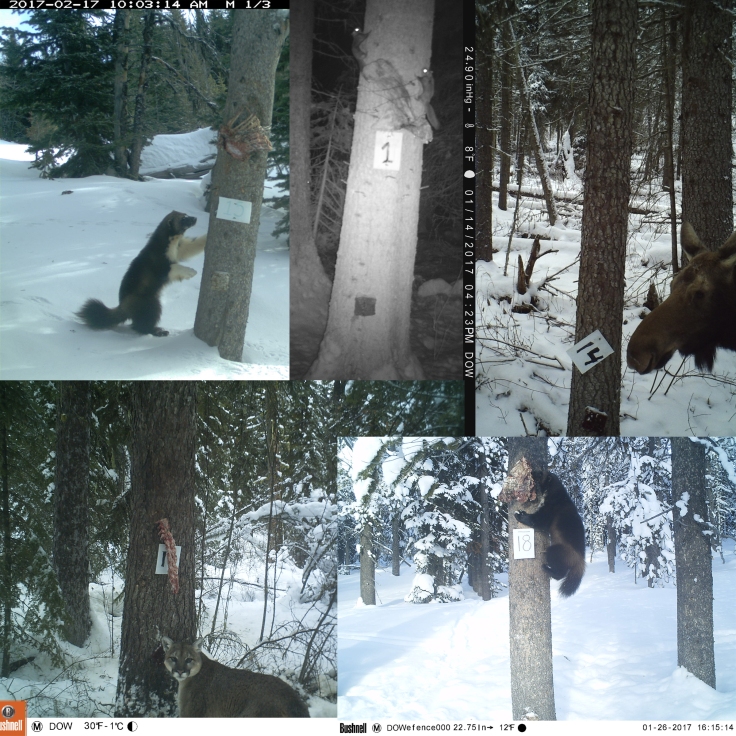Hello, I’m Savannah Stewart. I’m part of the Climate Change program here at UM. As part of the minor, students can choose to complete a climate-related internship. I’m currently in the midst of mine with the Defenders of Wildlife’s Wolverine Watchers Project. To start, I should give some background about the project. The Defenders of Wildlife is a national conservation organization that works to protect imperiled wildlife across the globe. They work through many facets on projects that cover issues such as habitat degradation, climate change, and renewable energy.
The particular project I’m working on is the Wolverine Watch, a citizen science project headed by Defenders and the Bitterroot National Forest. The goal of Wolverine Watchers is to monitor wildlife populations, especially wolverines, Canada lynx, and fishers, in the Bitterroot and Sapphire Mountains. In order to do this, teams of volunteers hike, snowshoe, or ski to remote locations to set up camera trap stations. These consist of a motion-sensitive wildlife camera facing a hunk of bait hung on a tree to attract the animals. There are also gun brushes stuck into the tree to collect hair samples that will be sent to a genetics lab for testing. The volunteers will recheck their stations and bring back data every 3-4 weeks until the end of the season.
Here, is where my job begins. I am the data entry intern for the project. That means I take all the information that comes in and enter it into a database. My mentors Russ Talmo and Kylie Paul trained me on how to enter the data properly and how to sort and label photos. It’s a pretty straightforward task. Every time a team checks their station, they bring back a packet of data consisting of a data sheet, a photo SD card, and, possibly, hair samples. I enter all the information from the sheet and the hair samples into spreadsheets. I then go to work sorting the photos and tag the ones picturing wildlife with the correct species name.
 Being able to identify Montana wildlife is extremely important for this internship. While I can recognize most of the critters easily, some can be a bit tricky. For instance, a card I recently sorted had a bird that was either a downy or a hairy woodpecker. The only obvious difference between these birds is the way the black and white on their head comes together at the back of the neck. I had to do some digging on plumage, the kind of habitat the birds use, and their distribution to determine that it was a hairy, not a downy, woodpecker. Besides the woodpecker, I have come across a range of animals so far, including bobcats, moose, martens, snowshoe hares, Clark’s nutcrackers, and, yes, wolverines! This year, wolverines have been spotted at least 8 stations. How exciting! Even cooler, a wolverine showed up at a station on the Sapphire side for the first time ever.
Being able to identify Montana wildlife is extremely important for this internship. While I can recognize most of the critters easily, some can be a bit tricky. For instance, a card I recently sorted had a bird that was either a downy or a hairy woodpecker. The only obvious difference between these birds is the way the black and white on their head comes together at the back of the neck. I had to do some digging on plumage, the kind of habitat the birds use, and their distribution to determine that it was a hairy, not a downy, woodpecker. Besides the woodpecker, I have come across a range of animals so far, including bobcats, moose, martens, snowshoe hares, Clark’s nutcrackers, and, yes, wolverines! This year, wolverines have been spotted at least 8 stations. How exciting! Even cooler, a wolverine showed up at a station on the Sapphire side for the first time ever.
While my work doesn’t directly involve climate change in the day to day, there is a profound, underlying connection. Wolverines, as well as lynx and fishers, are climate-sensitive species. This makes gathering more information about their populations very important. Because these species are cold adapted and rely on lots of snow, a changing climate could spell serious trouble. Diminishing snowpacks could be especially dangerous for wolverines in the US because they need deep snow to raise their kits in the spring. If a warming climate does reduce the snow, the amount of suitable habitat for wolverines could become smaller and smaller by the end of the century. The uncertain nature of how precipitation will change with warming makes it even more important to keep an eye on these sensitive, and rare, species. The Wolverine Watchers contributes to the knowledge base on the species and can help shape management decisions about the animals and their habitats in the future.
 This internship has been valuable to personally in many ways. First off, I have expanded my knowledge and skill base exponentially. I now know how to manage and enter data as well as identify many Montana wildlife species. These are highly marketable skills in my field of Wildlife Biology. I also know far more about wolverines and how they may respond to climate change. The internship allowed me to combine my love of wildlife and interest in protecting creatures from the effects of climate change. The project also connected me with incredible individuals within the Defenders of Wildlife organization and enhanced my ability to communicate effectively and work in a complicated and changing work environment. Overall, the internship has been an amazing experience so far and I can’t wait to see how ends.
This internship has been valuable to personally in many ways. First off, I have expanded my knowledge and skill base exponentially. I now know how to manage and enter data as well as identify many Montana wildlife species. These are highly marketable skills in my field of Wildlife Biology. I also know far more about wolverines and how they may respond to climate change. The internship allowed me to combine my love of wildlife and interest in protecting creatures from the effects of climate change. The project also connected me with incredible individuals within the Defenders of Wildlife organization and enhanced my ability to communicate effectively and work in a complicated and changing work environment. Overall, the internship has been an amazing experience so far and I can’t wait to see how ends.

Leave a comment